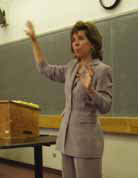Susan Neuman Discusses Education Policy
Neuman, who was a professor at the University of Michigan in Ann Arbor and director of the Center for the Improvement of Early Reading Achievement before being asked by President Bush to join the Department of Education, talked about what she called "Big P and Little P" in regard to policy. When she arrived in Washington, Neuman said, Bush was asking what should be done about schools and early childhood. "He produced a blueprint," she said, "A comprehensive blueprint of what structural changes were needed in the entire Elementary and Secondary Education Act."
That blueprint was the "No Child Left Behind" (NCLB) initiative. "The No Child Left Behind blueprint was policy with a 'Big P'," Neuman said. It had no legislative language behind it, but represented a set of ideas built on four essential pillars. Those pillars were: accountability, choice, flexibility, and what works.
Once NCLB was passed, the Secretary of Education was charged with implementing those pillars. Most of the tasks involved in creating the legislative language went to Neuman's office. "I didn't realize the complexity of this," she said. "Congress said we had to do Negotiated Rule Making," which involved creating focus groups made up of state representatives, parents, principals and teachers and asking them who they would like to see participate and what they want to see in standards and assessment. "For five days we talked about regulations, standards and assessment," she explained. They discussed what is being tested vs. what is being taught, special education children and the standards applied to their education, and what kind of testing should be developed.
Once the discussions were completed, the results were published and reviewed by the public. Every comment had to be dealt with, she said. Now it is law.
Her office also worked on a guide book on teacher quality and accountability. "It took months to write and is not law, but it now becomes the guide of the land," she said. "That is the 'Little P'," Neuman explained. "It's not glamorous." At the end of August, her office is putting out a free reference for every state that will provide a good summary of what each of the programs are designed to do and how things have been changed.
Published Monday, Feb. 3, 2003
